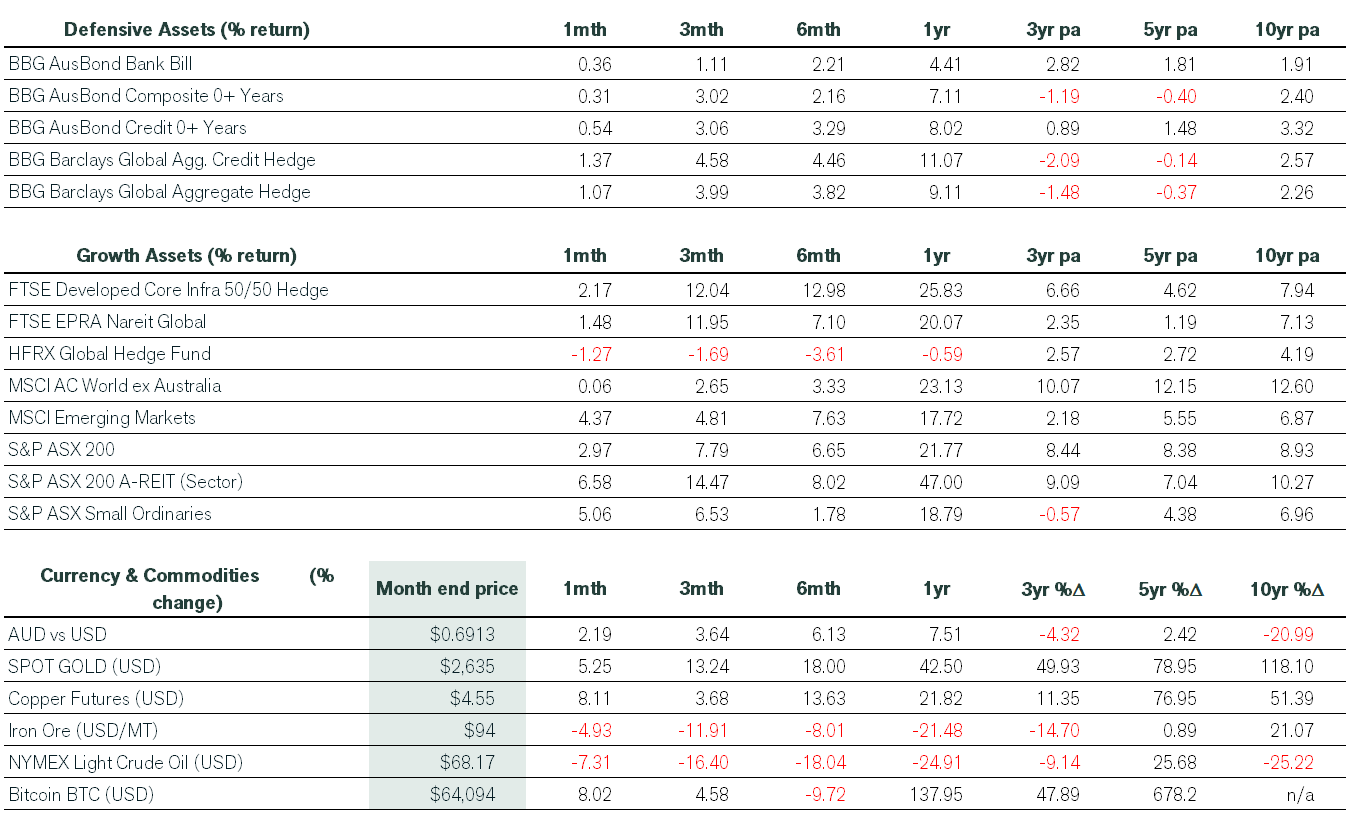September 2024 Economic & Market Review – Global Markets React to Fed Rate Cut and China’s Stimulus
Talking points
- The Fed’s Rate Cut Signals Caution, Not Victory: The US Federal Reserve made its first rate cut since 2020, dropping rates by 0.5%, but Chairman Jerome Powell was quick to clarify that this isn’t a sign of “mission accomplished” on inflation. The Fed is shifting focus towards a slowing economy as job growth decelerates, indicating more rate cuts may be on the horizon. However, Powell cautioned that this 0.5% cut shouldn’t be viewed as a trend-setting move for future decisions.
- Global Markets Rally Despite Currency Fluctuations: September saw global equities gain ground, but currency strength played a key role in shaping returns for domestic investors. For example, while emerging markets gained 5.6% in local terms, Australian investors saw only a 4.4% rise due to a stronger domestic dollar. The Australian stock market hit record highs, fueled by China’s stimulus package, while global infrastructure and property hedges provided stable returns.
- Emerging Markets Get a Boost from China’s Stimulus: China’s aggressive stimulus moves, including mortgage rate cuts and property purchase easements, injected new energy into its stock market. The CSI 300 index, tracking major stocks in Shanghai and Shenzhen, surged over 20% in September, officially entering a bull market.
- Bond Markets React to Global Rate Cuts: Global bond yields mostly dropped in response to declining interest rates, especially in the US, where the 10-year Treasury finished at 3.78%. However, Australia bucked the trend, with the RBA maintaining its hawkish stance, keeping domestic bond yields relatively unchanged. Financial conditions eased worldwide, boosting high-yield bonds, though Australia’s fixed income markets underperformed due to the RBA’s firm inflation stance.
- Commodities: A Mixed Bag Amid Stimulus and Tension: While iron ore futures surged by over 10% on China’s stimulus news, other commodities like crude oil faced downward pressure. Escalating tensions in the Middle East failed to push oil prices higher, contrasting with steady gains in gold and copper. Despite the global turmoil, certain commodities are proving resilient, reflecting divergent market reactions to economic stimuli and geopolitical factors.
Market Commentary
September will be mostly remembered for the US Federal Reserve (the Fed) cutting interest rates by half of a percentage point (-0.5%) to a 4.75-5% range. It was the first reduction since 2020, with the Fed signalling more reductions would follow. The Fed is currently less concerned with inflation and more concerned about a potentially weaker economy after jobs growth began to slow. Fed chair Jerome Powell noted that the policy change was not “mission accomplished” on inflation and cautioned against assuming the 0.5% cut sets a pace that Fed officials would continue.
In local currency terms, the MSCI ACWI ex-Australia index gained 1.9% in September. However, a further rally in the Australian dollar resulted in a weaker 0.1% return to unhedged domestic investors. Similarly, emerging market equities returned 5.6% in local currency terms, but this translated to a 4.4% gain in Australian dollars. Global hedge fund returns were wiped out by the higher domestic currency. Better performances emanated from hedged global infrastructure and hedged global property, which enjoyed returns of 3.1% and 2.0%, respectively.
The S&P 500 rose 2% for the month, taking its YTD return to 20.8%. The Dow Jones increased 1.9% in September and is up 12.3% in 2024. Meanwhile, the Nasdaq Composite gained 2.7%, marking its first positive September since 2019. Emerging market equities rose strongly on the announcement of a significant China stimulus package.
Meanwhile, the ASX 200 set a new record high on the final trading day of the month, driven by the mining sector’s response to China’s stimulus announcement. The ASX 200 finished the month 3.0% higher. Falling bond yields saw another surge in listed property stocks (+6.6%) and small caps (+5.1%). Listed property has now returned 47% over the last twelve months, partly due to AI-related distortions.
The Australian dollar finished September above US$0.69, while iron ore futures spiked more than 10%, the biggest intraday rise since September 2021. This culminated in the mining sector recording its best five-day return since October 2015.
Not to be outdone, China’s CSI 300 index of the largest stocks listed on the Shanghai and Shenzhen exchanges quickly entered a bull market, advancing more than 20% from the month’s low.
During September, most global interest rate markets exhibited a sharp “bull-steepening”. This occurs when interest rates decline across the yield curve, and shorter-term rates decline more than longer-term rates, i.e. the yield curve lowers and “steepens”. The US Federal Reserve’s mid-month 0.5% official interest rate cut was key in driving this performance pattern, but so were rising expectations of further rate cuts in Europe. In contrast, the Reserve Bank of Australia’s continued resistance to rate cuts (given Australia’s inflation dynamics) meant the Australian yield curve changed little over the month.
Global bond yields were generally lower, with the US 10yr Treasury note finishing the month at 3.78%. However, the domestic 10yr Commonwealth Government Bond inched up by less than 1bp to 3.97%.
In terms of performance in the fixed interest asset class, global credit markets surged due to a significant easing in financial conditions. High-yield bonds made solid capital gains after the Fed cut rate cuts, overshadowing the risks to the macro landscape. With the RBA remaining relatively hawkish, most domestic fixed interest segments underperformed global peers—but over the past year, they have still outperformed cash. However, the annualised returns over the last five years remain weak for traditional defensive asset classes as yields are now broadly higher than during that period.
Elsewhere, gold and copper made steady gains, while iron ore futures jumped on the final trading day (not reflected in our table) on the China stimulus announcement. In contrast, crude oil prices weakened despite escalating tensions in the Middle East.
Economic Commentary
Australia
In Australia, the Reserve Bank’s September board meeting resulted in no change to official interest rates for a seventh consecutive time. In the accompanying statement, the RBA stressed that underlying inflation remains too high and is more indicative of price momentum. There is increasing pressure on the RBA to cut rates after the June quarter GDP figures showed that the economy was close to stalling and that a per capita recession was showing no signs of reversing. Elsewhere, the August unemployment rate was steady at 4.2%, despite the creation of 47.5k jobs (above consensus).
Rest of world
Falling energy prices saw US inflation moderate to 2.5% in the year to August, marking the fifth straight annual drop and the smallest such increase since February 2021. However, core inflation remained sticky over the same period, printing at 3.2%, after shelter costs rose by 0.5% in August. Wages growth eased further in August, while jobs growth was modest at just 142k.
Meanwhile, China’s central bank announced it would lower the required reserve ratio, reduce borrowing costs on more than US$5 trillion of mortgages, and ease deposits for second homes. It later announced permission to refinance mortgages from November 1st, meaning borrowers on fixed-rate mortgages can negotiate cheaper loans. China also eased curbs on property purchases in its so-called tier-one cities, which have restricted non-local buyers to reduce speculation for years. Trading hub Guangzhou became the first major city to remove all restrictions on housing activity, ditching home buyer eligibility screening and no longer restricting the number of homes one person can own. Shanghai and Shenzhen loosened their rules too. Finally, authorities also announced US$100 billion of liquidity support for its beleaguered equity market and plans for a stock stabilisation fund.
Do you want to chat about what this means for your investments?
For personalised investment advice or to understand how this information may impact your investments, schedule a chat with a Pekada financial adviser today.
Pete is the Co-Founder, Principal Adviser and oversees the investment committee for Pekada. He has over 18 years of experience as a financial planner. Based in Melbourne, Pete is on a mission to help everyday Australians achieve financial independence and the lifestyle they dream of. Pete has been featured in Australian Financial Review, Money Magazine, Super Guide, Domain, American Express and Nest Egg. His qualifications include a Masters of Commerce (Financial Planning), SMSF Association SMSF Specialist Advisor™ (SSA) and Certified Investment Management Analyst® (CIMA®).


